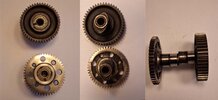I have an rear cam from a post war twin that has been welded to its wheel and and reprofiled after being built up with stelite. It has a number 3 stamped on the inboard end. Because it has been rebuilt I am not sure if I can rely on the 3 as a true identification, because it could be anything... The front cam has received the same treatment and no identifying number can be found anywhere.
So the first question is, how can I identify a cam?
When it was welded on, the wheel was 10 thou out so that as you spin the cam the wheel wobbles by 10 thou. This concerns me regarding meshing with the large idler.
Am I being over cautious?
What does the team think?
Best wishes and many thanks
So the first question is, how can I identify a cam?
When it was welded on, the wheel was 10 thou out so that as you spin the cam the wheel wobbles by 10 thou. This concerns me regarding meshing with the large idler.
Am I being over cautious?
What does the team think?
Best wishes and many thanks

